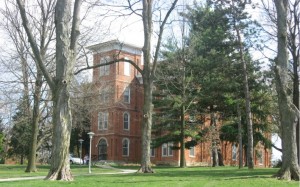 Like many church-related colleges, Wilmington College in Ohio—where I have taught for 13 years—confronts some seemingly insurmountable challenges in attempting to hold on to our unique Quaker identity in the world of higher education. Even though the college was founded in 1870 and maintains a formal affiliation with Wilmington Yearly Meeting, has a board of trustees made up of mostly Quakers, and a campus Friends meeting that meets in a replication of a historic meetinghouse, we struggle to communicate not only a historical legacy of Quakerism, but also the Quaker vision and a set of values to an overwhelmingly non-Quaker student body.
Like many church-related colleges, Wilmington College in Ohio—where I have taught for 13 years—confronts some seemingly insurmountable challenges in attempting to hold on to our unique Quaker identity in the world of higher education. Even though the college was founded in 1870 and maintains a formal affiliation with Wilmington Yearly Meeting, has a board of trustees made up of mostly Quakers, and a campus Friends meeting that meets in a replication of a historic meetinghouse, we struggle to communicate not only a historical legacy of Quakerism, but also the Quaker vision and a set of values to an overwhelmingly non-Quaker student body.
The challenges for Wilmington and other Friends colleges are compounded by the diversity of Quaker belief and Quakerism’s non-creedal nature. At Wilmington, where Quaker faculty and staff represent about 10 percent of its 200 employees, the range of affiliations—small, rural meetings; larger town meetings; programmed and unprogrammed meetings; FUM and FGC affiliated meetings—is very wide, representing very different perspectives on and experiences with the Religious Society of Friends. Add to that the non-Quaker faculty members’ varying connections to Quaker beliefs and practices, and you have no real consensus for what it means to be a Quaker college, no coherent vision for how our Quaker identity informs our educational mission.
Another variable in the mix would be the dominant values in higher education today, secular for the most part, which take students further and further away from thoughtful consideration of what it means to be human and to live in community given our culture’s emphasis on activities such as intercollegiate athletics, membership in fraternities and sororities, and a social life that sees alcohol consumption as an important rite of passage. One might think that these aspects of American higher education are to be found primarily at large public institutions, but all of these features characterize social and recreational life at Wilmington, a campus of just over 1000 students, making it even harder to communicate the sense of spiritual purpose that many believe should be part of an education at a school with a religious heritage and affiliation.
While the answers to the bigger question of what it means to be a Quaker college continue to elude the Wilmington community, the somewhat more manageable question of how we might communicate Quaker values to students in our teaching efforts is one that many faculty members, Quaker and non-Quaker alike, have undertaken to think about and experiment with. These efforts have often involved service learning projects, the incorporation of themes and activities related to international perspectives, and nonviolent resistance to social injustice. However, there have been few efforts to address specific aspects of Friends worship or the deep reflective practices that characterize much of early Friends as well as contemporary Friends journal writing, apart from official course offerings like Introduction to Quakerism.
I think it would be safe to say that the objective of Wilmington’s Quaker mission (however that has been construed) has never been to convert students to Quakerism; rather, it’s to bring students to what George Fox has described as the “teacher within,” the critical thinking and searching that we want students to engage in as a result of the kind of learning culture we’re trying to build. This is a vastly different learning culture from other, more traditional church-affiliated colleges. Education cannot be about sheltering students from the rigors of a genuine spiritual life or protecting students from unpleasant truths. In some ways, it is just the opposite. Mature faith calls us to reflect on the nature of faith itself and to develop solutions to life’s difficult problems—personal, interpersonal, national, global—with all the intelligence and creativity we as human beings can muster. But how do we bring students to this understanding when so much of contemporary life takes young people away from really knowing themselves, away from deeper understandings of what it means to be spiritual?
 One effort to address this issue of connecting Quaker sprituality with the curriculum took place in LeighAnn Oettinger’s remedial English composition class. As part of her reformulation of the remedial English composition course for incoming freshmen students, she decided to assign readings that would stimulate student interest in discussing and writing about issues that were important and, in some cases, controversial. These themes included racism, peace and social justice, gender and sexual identity, and religious identity and spirituality, for which she chose the text by Quaker pastor and writer J. Brent Bill: Holy Silence: The Gift of Quaker Spirituality. This was a deliberate decision on LeighAnn’s part to move away from subject matter that has been typically part of remedial English composition courses for these students (their first experiences with a roommate, the transition to college life, how college is different from high school) to more substantive issues that would stimulate student interest and require more analytical ways of looking at the world. It was also a way of introducing these first-year students to Wilmington’s Quaker heritage and the core values which Wilmington maintains are an important part of its mission.
One effort to address this issue of connecting Quaker sprituality with the curriculum took place in LeighAnn Oettinger’s remedial English composition class. As part of her reformulation of the remedial English composition course for incoming freshmen students, she decided to assign readings that would stimulate student interest in discussing and writing about issues that were important and, in some cases, controversial. These themes included racism, peace and social justice, gender and sexual identity, and religious identity and spirituality, for which she chose the text by Quaker pastor and writer J. Brent Bill: Holy Silence: The Gift of Quaker Spirituality. This was a deliberate decision on LeighAnn’s part to move away from subject matter that has been typically part of remedial English composition courses for these students (their first experiences with a roommate, the transition to college life, how college is different from high school) to more substantive issues that would stimulate student interest and require more analytical ways of looking at the world. It was also a way of introducing these first-year students to Wilmington’s Quaker heritage and the core values which Wilmington maintains are an important part of its mission.
Bill’s book may have been especially appropriate given that he is a graduate of Wilmington and a pastor in the programmed meeting tradition, writing about his own encounter with silent worship. The first chapter of Holy Silence narrates his and his wife’s experience of silent worship in a historic meetinghouse while they were vacationing in Vermont. He explains the origin of silence from a passage in the Bible where the prophet Elijah encounters God not in the wind, not in the earthquake, and not in the fire, but in the “sheer silence” that “gave him hope and strength to go on living.”
Based on this reading, LeighAnn chose to conduct an actual meeting for worship—or at the least a simulated meeting—in the manner of traditional Friends during class time. This was 20 minutes of centering silence that took place during the classes and in the middle of students’ busy academic day. She invited several Quaker faculty and staff members to participate, and the campus minister was asked to present introductory remarks which explained the purpose and nature of the meeting for worship, what might actually happen during such a worship service, and how messages in the form of vocal ministry might arise from the silence. While no messages were delivered in the course of these periods of silent worship, students were required to write about their experiences of the “holy silence.”
Given the nature and objectives of the composition course and our intention to present the findings to those attending the annual Friends Association for Higher Education conference, LeighAnn and I looked at students’ written responses to the readings and to the silent worship in two primary ways. First, we looked at the ways that students approached writing about these topics, finding that they did indeed demonstrate some of the approaches and strategies to the assignment talked about by various researchers in the field of writing development. For example, they summarized, but used their summaries as a point of departure to analyze the religious significance of silent worship and their own personal response to it. In addition, there was evidence of real engagement with the material; the students were able to think in more than just one way about the experience of silent worship. Some of the comments are as follows:
“Taking time out to observe the world around us; the silence as healing; helping me think to get my priorities straight; time to think is what we need most to reflect, to figure out our errors, to reflect on happiness and life in general.”
“Closer to God in silence; mind opening; different, given that I am a Christian.”
“One way to truly hear the word of the Lord; Elijah passage; worshipping in this manner made me feel like God was more present.”
“God as person; a search for connection with the Lord; realized that He was best found in silence; refreshing, but difficult to just relax; controlled breathing helped; uncertain that I could sit through an hour of silence.”
“Even though it is almost the same as Catholic worship, everyone should take the time to learn new things and how others think about my religion.”
“Confused, wanted to laugh, mind wandering everywhere—very hard for me.”
“New, but familiar in some ways; key to God for Quakers is silence; Quakers, great to look up to; difficult to concentrate.”
“Worship God just the same; same personal connection to Jesus; difficult, but unique; thoughts flooded my head.”
“A conversation with God; validation.”
“Awkwardness of the silence; did not like; re-visualizing things I didn’t want to see again; discipline required.”
“Group psychology meeting; cozy; satisfied with the message God had given them.”
“The idea of silent worship was new; astonishing; it could get you closer to Christ on a whole new level; the difficulty of remaining quiet.”
We saw unqualified and uncritical approval of Quakers in some student papers when, for example, one student described the Quaker visitors as “experts” when it came to silent worship. But we also saw comparisons of the ways in which people “connect to God” and an acknowledgment and appreciation of the differences among religious traditions in this regard. In addition, other students recognized and wrote about the difficulties involved in this kind of worship, the potential problems involved, and the felt need for “something more.” Many saw the experience as alien, while others wrote about it as unpleasant, provoking renewed awareness of difficult issues in their lives about which they didn’t want to be reminded. Mostly, however, the experience was described and written about in religious terms and in connection with the students’ own religious backgrounds. Silence was not a part of the tradition in which they grew up, and many were not used to or even comfortable with it. Still, most of these students could understand that this was the way in which Quakers make contact or communicate with God, one of many ways that people express their interest and commitment to “ultimate” concerns.
 In looking at these comments from students who have not found it easy to express their thoughts in writing, one might be struck by the deep connections that many of them made to the experience of silent worship. We were particularly impressed by the comment regarding the “healing” nature of the silence and the opportunities that this experiment afforded this small group of students to reflect and simply observe the world around them. Again, this is not something that is cultivated in our current plugged-in, “commodified” college culture, and while it was not surprising to observe that the experience of centering or meditative silence was unsettling for some (“awkwardness of the silence, “discipline required,” “mind wandering everywhere”), this brief foray into what Quakers consider to be holy silence may be precisely what is missing in the college experience today—the opportunity to be alone with one’s thoughts and to experience a reality larger than oneself, what many identify as “God” or “Christ.” This very small scale exercise appeared to have enabled this particular group of students to see some of what John Woolman—highly regarded Quaker preacher and early abolitionist—has referred to as the “connections” among things.
In looking at these comments from students who have not found it easy to express their thoughts in writing, one might be struck by the deep connections that many of them made to the experience of silent worship. We were particularly impressed by the comment regarding the “healing” nature of the silence and the opportunities that this experiment afforded this small group of students to reflect and simply observe the world around them. Again, this is not something that is cultivated in our current plugged-in, “commodified” college culture, and while it was not surprising to observe that the experience of centering or meditative silence was unsettling for some (“awkwardness of the silence, “discipline required,” “mind wandering everywhere”), this brief foray into what Quakers consider to be holy silence may be precisely what is missing in the college experience today—the opportunity to be alone with one’s thoughts and to experience a reality larger than oneself, what many identify as “God” or “Christ.” This very small scale exercise appeared to have enabled this particular group of students to see some of what John Woolman—highly regarded Quaker preacher and early abolitionist—has referred to as the “connections” among things.
In that chapter from the book that students were asked to read as part of their assignment, Bill writes about silence as a form of intimacy:
When we really want to hear, and be heard by, someone we love, we do not go rushing into noisy crowds. Silence is a form of intimacy. That’s how we experience it with our friends and lovers. As relationships grow deeper and more intimate, we spend more and more quiet time alone with our lover. We talk in low tones about the things that matter. We do not shout them to each other. We may shout about them to others, but quietness is the hallmark of love”(7).
The point that Bill makes in reference to silence may have broader significance for education at Quaker schools, namely that a transformative education is an intimate affair. Transformative education is about raising questions that matter in learning environments where we can really listen to and be heard by others.
In the end, Quaker education may be mostly about the active and creative silence we can bring to the classroom. It is a silence needed to enter into real relationships with others as well as with knowledge, a silence too often missing from contemporary life, including and perhaps especially on college campuses.



Comments on Friendsjournal.org may be used in the Forum of the print magazine and may be edited for length and clarity.